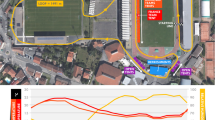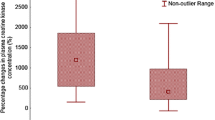Abstract
The prevalence of exercise-associated hyponatraemia (EAH) has been investigated in endurance athletes such as runners and Ironman triathletes, but not in ultra-endurance road cyclists. We assessed fluid intake and changes in body mass, urine specific gravity and plasma sodium concentration ([Na+]) in 65 ultra-endurance road cyclists in a 720-km ultra-cycling marathon, the ‘Swiss Cycling Marathon’. The cyclists lost 1.5 (1.7)% body mass (P < 0.01). No athlete developed EAH. Fluid intake was associated with the change in plasma [Na+] (r = −0.32, P < 0.05) and the change in body mass (r = −0.30, P < 0.05). The change in plasma [Na+] was related to post-race plasma [Na+] (r = 0.63, P < 0.0001). To conclude, ad libitum fluid intake in ultra-endurance cyclists in a single-stage ultra-endurance road cycling race showed no case of EAH. Future studies regarding drinking behaviour in different ultra-endurance disciplines might give insights into why the prevalence of EAH is different in the different disciplines.






Similar content being viewed by others
References
Almond CS, Shin AY, Fortescue EB, Mannix RC, Wypij D, Binstadt BA, Duncan CN, Duncan CN, Olson DP, Salerno AE, Newburger JW, Greenes DS (2005) Hyponatremia among runners in the Boston Marathon. N Engl J Med 352:1550–1556
Baker LB, Munce TA, Kenney WL (2005) Sex differences in voluntary fluid intake by older adults during exercise. Med Sci Sports Exerc 37:789–796
Becque MD, Katch VL, Moffatt RJ (1986) Time course of skin-plus-fat compression in males and females. Hum Biol 58:33–42
Beltrami FG, Hew-Butler T, Noakes TD (2008) Drinking policies and exercise-associated hyponatraemia: is anyone still promoting overdrinking? Br J Sports Med 42:496–501
Chorley J, Cianca J, Divine J (2007) Risk factors for exercise-associated hyponatremia in non-elite marathon-runners. Clin J Sport Med 17:471–477
Dugas JP, Noakes TD (2005) Hyponatraemic encephalopathy despite a modest rate of fluid intake during a 109 km cycle race. Br J Sports Med 39:e38 discussion e38
Hew TD, Chorley JN, Cianca JC, Divine JG (2003) The incidence, risk factors and clinical manifestations of hyponatremia in marathon runners. Clin J Sport Med 13:41–47
Hew-Butler T, Almond C, Ayus JC, Dugas J, Meeuwisse W, Noakes T, Reid S, Siegel A, Speedy D, Stuempfle K, Verbalis J, Weschler L, Exercise-Associated Hyponatremia (EAH) Consensus Panel (2005) Consensus statement of the First International Exercise-Associated Hyponatremia Consensus Development Conference, Cape Town, South Africa. Clin J Sport Med 15:208–213
Hew-Butler TD, Sharwood K, Collins M, Speedy D, Noakes T (2006) Sodium supplementation is not required to maintain serum sodium concentrations during an Ironman triathlon. Br J Sports Med 40:255–259
Hew-Butler T, Collins M, Bosch A, Sharwood K, Wilson G, Armstrong M, Jennings C, Swart J, Noakes T (2007) Maintenance of plasma volume and serum sodium concentration despite body weight loss in ironman triathletes. Clin J Sport Med 17:116–122
Hew-Butler T, Ayus JC, Kipps C, Maughan RJ, Mettler S, Meeuwisse WH, Page AJ, Reid SA, Rehrer NJ, Roberts WO, Rogers IR, Rosner MH, Siegel AJ, Speedy DB, Stuempfle KJ, Verbalis JG, Weschler LB, Wharam P (2008) Statement of the Second International Exercise-Associated Hyponatremia Consensus Development Conference, New Zealand, 2007. Clin J Sport Med 18:111–121
Hew-Butler T, Dugas JP, Noakes TD, Verbalis JG (2010) Changes in plasma arginine vasopressin concentrations in cyclists participating in a 109-km cycle race. Br J Sports Med 44:594–597
Irving RA, Noakes TD, Buck R, van Zyl Smit R, Raine E, Godlonton J, Norman RJ (1991) Evaluation of renal function and fluid homeostasis during recovery from exercise-induced hyponatremia. J Appl Physiol 70:342–348
Kavouras SA (2002) Assessing hydration status. Curr Opin Clin Nutr Metab Care 5:519–524
Kipps C, Sharma S, Pedoe DT (2011) The incidence of exercise-associated hyponatremia in the London Marathon. Br J Sports Med 45:14–19
Knechtle B, Knechtle P, Rosemann T, Senn O (2009a) No dehydration in mountain bike ultra-marathoners. Clin J Sport Med 19:415–420
Knechtle B, Wirth A, Knechtle P, Rosemann T (2009b) An ultra-cycling race leads to no decrease in skeletal muscle mass. Int J Sports Med 30:163–167
Knechtle B, Joleska I, Wirth A, Knechtle P, Rosemann T, Senn O (2010a) Intra- and inter-judge reliabilities in measuring the skin-fold thicknesses of ultra runners under field conditions. Percept Mot Skills 111:105–106
Knechtle B, Knechtle P, Rosemann T (2010b) No exercise-associated hyponatremia found in an observational field study of male ultra-marathoners participating in a 24-hour ultra-run. Phys Sportsmed 38:94–100
Knechtle B, Wirth A, Knechtle P, Rosemann T, Senn O (2011a) Do ultra-runners in a 24-h run really dehydrate? Ir J Med Sci 180:129–134
Knechtle B, Knechtle P, Rosemann T (2011b) Low prevalence of exercise-associated hyponatremia in male 100 km ultra-marathon runners in Switzerland. Eur J Appl Physiol 111(6):1007–1016
Knechtle B, Knechtle P, Rosemann T (2011c) No case of exercise-associated hyponatremia in male ultra-endurance mountain bikers in the ‘Swiss Bike Masters’. Chin J Physiol. doi:10.4077/CJP.2011.AMM050
Knechtle B, Knechtle P, Rüst CA, Rosemann T, Lepers R (2011d) Finishers and non-finishers in the ‘Swiss Cycling Marathon’ to qualify for the ‘Race across America’. J Strength Cond Res, in press
Knechtle B, Gnädinger M, Knechtle P, Imoberdorf R, Kohler G, Ballmer P, Rosemann T, Senn O (2011e) Prevalence of exercise-associated hyponatremia in male ultraendurance athletes. Clin J Sport Med 21(3):226–232
Kruseman M, Bucher S, Bovard M, Kayser B, Bovier PA (2005) Nutrient intake and performance during a mountain marathon: an observational study. Eur J Appl Physiol 94:151–157
Lee RC, Wang Z, Heo M, Ross R, Janssen I, Heymsfield SB (2000) Total-body skeletal muscle mass: development and cross-validation of anthropometric prediction models. Am J Clin Nutr 72:796–803
Lee JK, Nio AQ, Ang WH, Johnson C, Aziz AR, Lim CL, Hew-Butler T (2011) First reported cases of exercise-associated hyponatremia in Asia. Int J Sports Med, epub ahead of print
Mettler S, Rusch C, Frey WO, Bestmann L, Wenk C, Colombani PC (2008) Hyponatremia among runners in the Zurich Marathon. Clin J Sport Med 18:344–349
Noakes TD (2003) Overconsumption of fluids by athletes. BMJ 327:113–114
Noakes TD (2011) Changes in body mass alone explain almost all of the variance in the serum sodium concentrations during prolonged exercise. Has commercial influence impeded scientific endeavour? Br J Sports Med, epub ahead of print
Noakes TD, Goodwin N, Rayner BL, Branken T, Taylor RK (1985) Water intoxication: a possible complication during endurance exercise. Med Sci Sports Exerc 17:370–375
Noakes TD, Sharwood K, Speedy D, Hew T, Reid S, Dugas J, Almond C, Wharam P, Weschler L (2005) Three independent biological mechanisms cause exercise-associated hyponatremia: evidence from 2, 135 weighed competitive athletic performances. Proc Natl Acad Sci USA 102:18550–18555
Reid SA, King MJ (2007) Serum biochemistry and morbidity among runners presenting for medical care after an Australian mountain ultramarathon. Clin J Sport Med 17:307–310
Rose S, Peters-Futre EM (2010) Ad libitum adjustments to fluid intake in cool environmental conditions maintain hydration status in a three-day mountain bike race. Br J Sports Med 44:430–436
Sawka MN, Burke LM, Eichner ER, Maughan RJ, Montain SJ, Stachenfeld NS, American College of Sports Medicine (2007) American College of Sports Medicine position stand. Exercise and fluid replacement. Med Sci Sports Exerc 39:377–390
Schenk K, Gatterer H, Ferrari M, Ferrari P, Cascio VL, Burtscher M (2010) Bike Transalp 2008: liquid intake and its effect on the body’s fluid homeostasis in the course of a multistage, cross-country, MTB marathon race in the central Alps. Clin J Sport Med 20:47–52
Sharwood K, Collins M, Goedecke J, Wilson G, Noakes T (2002) Weight changes, sodium levels, and performance in the South African Ironman Triathlon. Clin J Sport Med 12:391–399
Shirreffs SM (2003) Markers of hydration status. Eur J Clin Nutr 57:S6–S9
Speedy DB, Faris JG, Hamlin M, Gallagher PG, Campbell RG (1997) Hyponatremia and weight changes in an ultradistance triathlon. Clin J Sport Med 7:180–184
Speedy DB, Noakes TD, Rogers IR, Thompson JM, Campbell RG, Kuttner JA, Boswell DR, Wright S, Hamlin M (1999) Hyponatremia in ultradistance triathletes. Med Sci Sports Exerc 31:809–815
Speedy DB, Noakes TD, Kimber NE, Rogers IR, Thompson JM, Boswell DR, Ross JJ, Campbell RG, Gallagher PG, Kuttner JA (2001a) Fluid balance during and after an Ironman triathlon. Clin J Sport Med 11:44–50
Speedy DB, Noakes TD, Schneider C (2001b) Exercise-associated hyponatremia: a review. Emerg Med (Fremantle) 13:17–27
Speedy DB, Thompson JM, Rodgers I, Collins M, Sharwood K, Noakes TD (2002) Oral salt supplementation during ultradistance exercise. Clin J Sport Med 12:279–284
Stewart AD, Hannan WJ (2000) Prediction of fat mass and fat-free mass in male athletes using dual X-ray absorptiometry as the reference method. J Sports Sci 18:263–274
Stuempfle KJ, Lehmann DR, Case HS, Bailey S, Hughes SL, McKenzie J, Evans D (2002) Hyponatremia in a cold weather ultraendurance race. Alaska Med 44:51–55
Stuempfle KJ, Lehmann DR, Case HS, Hughes SL, Evans D (2003) Change in serum sodium concentration during a cold weather ultradistance race. Clin J Sport Med 13:171–175
Van Beaumont W (1972) Evaluation of hemoconcentration from hematocrit measurements. J Appl Physiol 32:712–713
Wharam PC, Speedy DB, Noakes TD, Thompson JM, Reid SA, Holtzhausen LM (2006) NSAID use increases the risk of developing hyponatremia during an Ironman triathlon. Med Sci Sports Exerc 38:618–622
Winger JM, Dugas JP, Dugas LR (2011) Beliefs about hydration and physiology drive drinking behaviours in runners. Br J Sports Med, epub ahead of print
Author information
Authors and Affiliations
Corresponding author
Additional information
Communicated by Susan A. Ward.
Rights and permissions
About this article
Cite this article
Rüst, C.A., Knechtle, B., Knechtle, P. et al. No case of exercise-associated hyponatraemia in top male ultra-endurance cyclists: the ‘Swiss Cycling Marathon’. Eur J Appl Physiol 112, 689–697 (2012). https://doi.org/10.1007/s00421-011-2024-y
Received:
Accepted:
Published:
Issue Date:
DOI: https://doi.org/10.1007/s00421-011-2024-y




